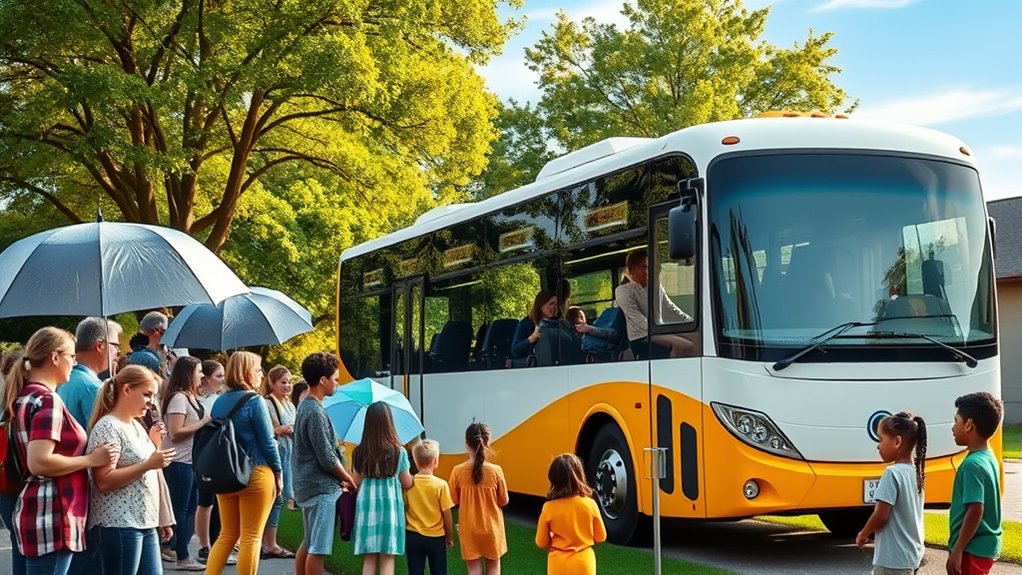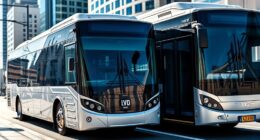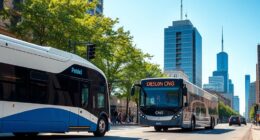Parents generally feel positive about electric school buses because they see them as safer and healthier options. These buses produce no tailpipe emissions, reducing exposure to harmful air pollutants around schools. They also tend to operate more quietly and smoothly, offering a more comfortable ride for children. Many trust the advanced safety features, like cameras and collision avoidance systems, to keep students secure. To find out more about how these buses benefit children’s health and safety, keep exploring further.
Key Takeaways
- Parents appreciate the reduced air pollution and noise, promoting healthier and less stressful school commutes for children.
- Safety features like reinforced frames and advanced driver assistance systems reassure parents about student security.
- Concerns about battery manufacturing and disposal impacts are balanced by the environmental benefits of zero emissions during operation.
- Transparency regarding maintenance, safety inspections, and safety protocols is important for parental trust.
- Overall, parents view electric buses as safer, healthier, and more environmentally friendly alternatives to traditional diesel models.

As more school districts switch to electric buses, parents are increasingly concerned about safety and health implications. One of the primary worries revolves around pollution concerns. Unlike traditional diesel-powered buses, electric buses produce zero tailpipe emissions, which means they don’t release harmful pollutants like nitrogen oxides or particulate matter into the air. This shift could notably improve air quality around schools, especially in urban areas where pollution levels tend to be higher. Parents see this as a positive step toward creating a healthier environment for children, reducing their exposure to airborne toxins that can cause respiratory issues or other health problems. However, some parents are still cautious, wondering about the long-term effects of electric vehicle emissions, such as those from battery manufacturing and disposal. They want assurances that the overall environmental footprint of electric buses is genuinely lower and that their children are protected from both direct and indirect pollutants.
In addition to pollution concerns, parents are paying close attention to the bus design features that influence safety and comfort. Electric buses are often built with modern safety standards, including reinforced frames and improved driver visibility, which can make them safer than older models. Many models come equipped with advanced safety technologies like collision avoidance systems, cameras, and automatic braking, giving parents peace of mind about their children’s protection. Comfort is also a key concern, as children spend a significant amount of time on the bus. Electric buses tend to operate more smoothly and quietly, reducing noise pollution and making the ride less stressful for students. Some parents appreciate that electric buses don’t produce exhaust fumes, which can cause discomfort or even health issues for children sensitive to air pollutants.
Furthermore, the battery technology used in electric buses is advancing rapidly, which may help address concerns about sustainability and environmental impact over time. Parents are also interested in how these buses are maintained and whether routine safety checks are consistently performed to ensure ongoing security. Features like low floors for easier boarding, secure seating arrangements, and improved ventilation are common in electric models. Parents value these enhancements because they demonstrate a commitment to safety and inclusivity. Still, some worry about how well these features are maintained and whether the buses are regularly inspected for safety compliance. They want transparency from school districts about maintenance routines, driver training, and safety protocols to ensure their children are riding in secure and well-maintained vehicles.
Frequently Asked Questions
How Do Electric Buses Impact Overall School Transportation Costs?
Electric buses reduce overall school transportation costs by providing significant cost savings on fuel and energy. You’ll notice lower fuel expenses since electricity is cheaper than diesel. Plus, maintenance benefits mean fewer repairs and less downtime, which further cuts costs. While upfront investment might be higher, the long-term savings and reduced maintenance make electric buses a smart financial choice for your school district.
Are Electric School Buses Accessible for Students With Disabilities?
Of course, electric school buses are accessible for students with disabilities—it’s 2024, after all! They’re designed with inclusive transportation in mind, featuring ramps, lifts, and secure seating. You can’t expect these eco-friendly rides to leave anyone behind, literally or figuratively. So yes, electric buses prioritize disability accessibility, ensuring every student can enjoy safe, inclusive transportation without feeling like they’re riding in the stone age.
What Are Parents’ Concerns About Charging Infrastructure Near Schools?
You might worry about charging safety and whether infrastructure availability supports electric school buses near your child’s school. Concerns include the reliability of charging stations, possible disruptions if infrastructure isn’t sufficient, and safety risks during charging. You want to make certain there are enough accessible, well-maintained charging points that won’t cause delays or hazards. A strong, reliable charging infrastructure reassures you that electric buses are a safe, practical option for your child’s transportation.
How Do Electric Buses Perform in Extreme Weather Conditions?
Ever wonder if electric buses can handle extreme weather? They generally perform well, thanks to advanced thermal management systems that protect the battery performance in cold or hot conditions. While very low temperatures might slightly reduce range, proper insulation and heating technologies guarantee safe, reliable operation. So, you can trust that these buses are designed to adapt, keeping kids safe and comfortable no matter the weather outside.
What Training Is Provided for Drivers Operating Electric School Buses?
You receive thorough driver training that covers operating electric school buses safely and efficiently. This training includes instruction on safety protocols, such as managing battery levels, handling charging stations, and responding to emergencies. Drivers also learn how to navigate different weather conditions and ensure passenger safety. Regular refresher courses help maintain high safety standards, giving you confidence and preparedness for all situations while prioritizing student safety and health.
Conclusion
As a parent, your child’s safety and health are top priorities. Did you know that electric school buses produce 90% fewer emissions than traditional diesel buses? That means cleaner air and healthier lungs for your kids. Most parents feel more confident with electric buses, citing improved air quality and quieter rides. Embracing this new technology can give you peace of mind, knowing you’re helping create a safer, healthier environment for your children’s daily commute.









